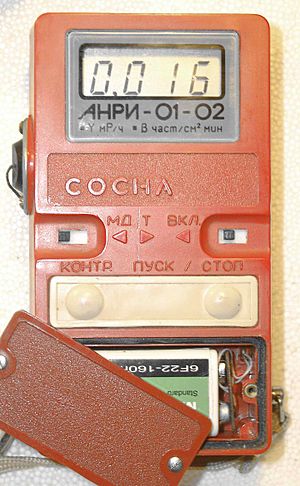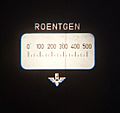Dosimeter facts for kids
A dosimeter is a special tool that helps measure how much of something, like sound or radiation, is in an area. It's like a tiny sensor that tells you if an environment is safe. Dosimeters are super important for keeping people safe from things that could be harmful, even if you can't see or hear them.
Contents
What is a Dosimeter?
A dosimeter is a device that measures and records the amount of exposure a person or an area has received to something. This "something" can be different things, but the most common ones are sound and radiation. Think of it as a personal safety monitor.
How Do Dosimeters Work?
Dosimeters work by detecting and measuring specific types of energy or particles. For example, a sound dosimeter has a microphone that picks up noise. It then calculates how loud the noise is over time. A radiation dosimeter has special sensors that react to radiation, allowing it to measure the amount present.
Types of Dosimeters
There are different kinds of dosimeters, each designed to measure a specific type of exposure.
Radiation Dosimeters
Radiation dosimeters measure radiation. Radiation is a form of energy that travels in waves or particles. While some radiation is natural and harmless, too much can be bad for your health. Radiation dosimeters are used in places like hospitals, nuclear power plants, or research labs. They help protect workers and the public by showing if radiation levels are safe. Some dosimeters measure radiation in the air, while others are worn by people to track their personal exposure.
Sound Dosimeters
Sound dosimeters measure noise levels. They are often called noise dosimeters. These devices are used to check how loud a workplace or an environment is. Too much loud noise can damage your hearing over time. Workers in noisy factories or construction sites might wear sound dosimeters. This helps them know if they need to wear hearing protection.
Why Are Dosimeters Important?
Dosimeters play a big role in keeping us safe and healthy. They help people understand if they are in a safe environment. For example, they are used to:
- Protect workers from dangerous levels of radiation or noise.
- Ensure that hospitals and other facilities are safe.
- Help scientists study different environments.
- Monitor areas after accidents, like a nuclear incident.
By using dosimeters, we can make sure that people are not exposed to harmful levels of things they can't easily detect on their own.
Related pages
Images for kids
See also
 In Spanish: Dosímetro para niños
In Spanish: Dosímetro para niños











